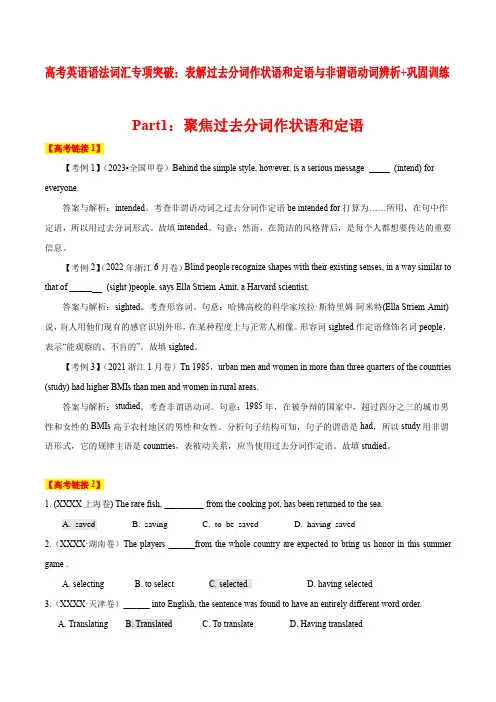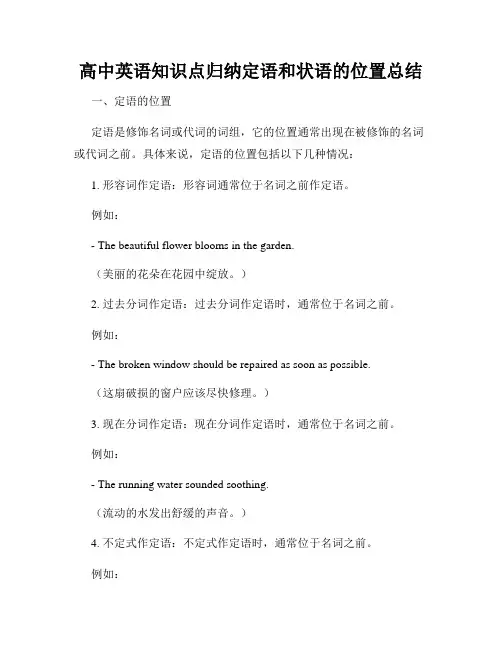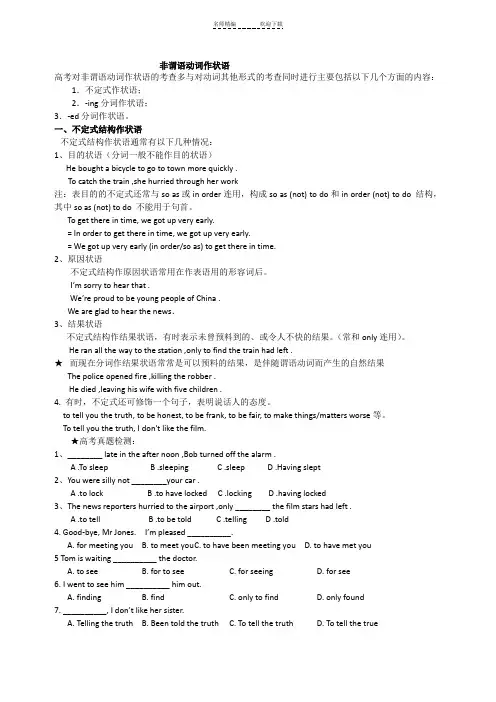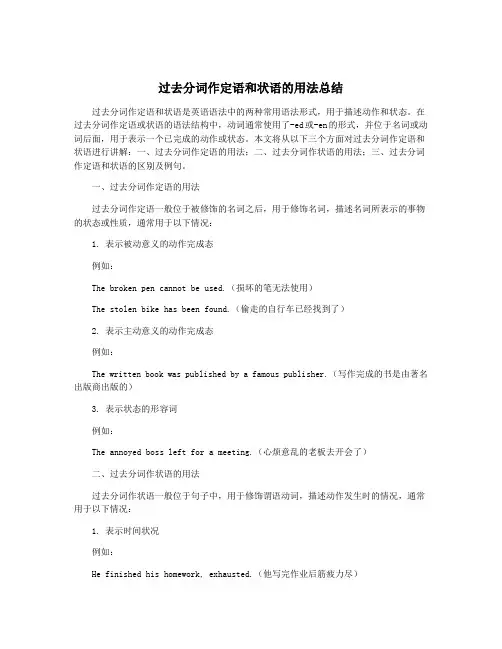高考英语作定语和状语的分词-P
- 格式:pdf
- 大小:272.05 KB
- 文档页数:9

高考英语语法词汇专项突破:表解过去分词作状语和定语与非谓语动词辨析+巩固训练Part1:聚焦过去分词作状语和定语【高考链接1】everyone.答案与解析:intended。
考查非谓语动词之过去分词作定语be intended for打算为……所用,在句中作定语,所以用过去分词形式。
故填intended。
句意:然而,在简洁的风格背后,是每个人都想要传达的重要信息。
【考例2】(2022年浙江6月卷)Blind people recognize shapes with their existing senses, in a way similar to that of _____ (sight )people, says Ella Striem-Amit, a Harvard scientist.答案与解析:sighted。
考查形容词。
句意:哈佛高校的科学家埃拉·斯特里姆-阿米特(Ella Striem-Amit)说,盲人用他们现有的感官识别外形,在某种程度上与正常人相像。
形容词sighted作定语修饰名词people,表示“能观察的、不盲的”。
故填sighted。
【考例3】(2021浙江1月卷)Tn 1985,urban men and women in more than three quarters of the countries (study) had higher BMIs than men and women in rural areas.答案与解析:studied。
考查非谓语动词。
句意:1985年,在被争辩的国家中,超过四分之三的城市男性和女性的BMIs高于农村地区的男性和女性。
分析句子结构可知,句子的谓语是had,所以study用非谓语形式,它的规律主语是countries,表被动关系,应当使用过去分词作定语。
故填studied。
【高考链接2】1. (XXXX上海卷) The rare fish, _________ from the cooking pot, has been returned to the sea.A. savedB. savingC. to be savedD. having saved2.(XXXX·湖南卷)The players ______from the whole country are expected to bring us honor in this summer game .A. selectingB. to selectC. selectedD. having selected3.(XXXX·天津卷)______ into English, the sentence was found to have an entirely different word order.A. TranslatingB. TranslatedC. To translateD. Having translated4.( XXXX全国卷II 11)Though ______ to see us,the professor gave us a warm welcome。

高中英语知识点归纳定语和状语的位置总结一、定语的位置定语是修饰名词或代词的词组,它的位置通常出现在被修饰的名词或代词之前。
具体来说,定语的位置包括以下几种情况:1. 形容词作定语:形容词通常位于名词之前作定语。
例如:- The beautiful flower blooms in the garden.(美丽的花朵在花园中绽放。
)2. 过去分词作定语:过去分词作定语时,通常位于名词之前。
例如:- The broken window should be repaired as soon as possible.(这扇破损的窗户应该尽快修理。
)3. 现在分词作定语:现在分词作定语时,通常位于名词之前。
例如:- The running water sounded soothing.(流动的水发出舒缓的声音。
)4. 不定式作定语:不定式作定语时,通常位于名词之前。
例如:- She has a lot of books to read during the summer vacation.(暑假期间她有很多书要读。
)5. 介词短语作定语:介词短语作定语时,通常位于名词之前。
例如:- The man in the black suit is my boss.(穿黑色西装的那个男人是我的老板。
)二、状语的位置状语是用来修饰动词、形容词、副词或整个句子的词组,它的位置可以灵活地放在句子中的不同位置。
具体来说,状语的位置包括以下几种情况:1. 状语放在句首:状语放在句首时,用来强调或引起注意。
例如:- In the morning, I usually go jogging.(早上,我通常去慢跑。
)2. 状语放在句中:状语放在句中时,用来补充说明或修饰动词、形容词或副词。
例如:- She spoke confidently during the presentation.(她在演讲过程中表现得很自信。
)3. 状语放在句尾:状语放在句尾时,用来总结、强调或表示结果。


非谓语动词作状语高考对非谓语动词作状语的考查多与对动词其他形式的考查同时进行主要包括以下几个方面的内容:1.不定式作状语;2.-ing分词作状语;3.-ed分词作状语。
一、不定式结构作状语不定式结构作状语通常有以下几种情况:1、目的状语(分词一般不能作目的状语)He bought a bicycle to go to town more quickly .To catch the train ,she hurried through her work注:表目的的不定式还常与so as或in order连用,构成so as (not) to do和in order (not) to do 结构,其中so as (not) to do 不能用于句首。
To get there in time, we got up very early.= In order to get there in time, we got up very early.= We got up very early (in order/so as) to get there in time.2、原因状语不定式结构作原因状语常用在作表语用的形容词后。
I’m sorry to hear that .We’re proud to b e young people of China .We are glad to hear the news.3、结果状语不定式结构作结果状语,有时表示未曾预料到的、或令人不快的结果。
(常和only连用)。
He ran all the way to the station ,only to find the train had left .★而现在分词作结果状语常常是可以预料的结果,是伴随谓语动词而产生的自然结果The police opened fire ,killing the robber .He died ,leaving his wife with five children .4. 有时,不定式还可修饰一个句子,表明说话人的态度。




过去分词作定语和状语的用法总结过去分词作定语和状语是英语语法中的两种常用语法形式,用于描述动作和状态。
在过去分词作定语或状语的语法结构中,动词通常使用了-ed或-en的形式,并位于名词或动词后面,用于表示一个已完成的动作或状态。
本文将从以下三个方面对过去分词作定语和状语进行讲解:一、过去分词作定语的用法;二、过去分词作状语的用法;三、过去分词作定语和状语的区别及例句。
一、过去分词作定语的用法过去分词作定语一般位于被修饰的名词之后,用于修饰名词,描述名词所表示的事物的状态或性质,通常用于以下情况:1. 表示被动意义的动作完成态例如:The broken pen cannot be used.(损坏的笔无法使用)The stolen bike has been found.(偷走的自行车已经找到了)2. 表示主动意义的动作完成态例如:The written book was published by a famous publisher.(写作完成的书是由著名出版商出版的)3. 表示状态的形容词例如:The annoyed boss left for a meeting.(心烦意乱的老板去开会了)二、过去分词作状语的用法过去分词作状语一般位于句子中,用于修饰谓语动词,描述动作发生时的情况,通常用于以下情况:1. 表示时间状况例如:He finished his homework, exhausted.(他写完作业后筋疲力尽)She stood there, frozen with fear.(她站在那里,惊恐万分)2. 表示原因或结果例如:Having saved enough money, he bought a new car.(存够了钱,他买了一辆新车)Being late for the meeting, they missed their chance.(因为迟到,他们错过了机会。
)3. 表示条件状况例如:Having finished the task, he went home.(完成任务后,他回家了)三、过去分词作定语和状语的区别及例句过去分词作定语和状语的最大区别在于它们所修饰的词不同。



英语后置定语和后置分词作状语
英语中的后置定语是指修饰名词的定语放在名词的后面的结构。
这种结构在英语中相对较少见,但在一些情况下会用到。
例如,在
表示时间的名词后面放置的定语,比如"the year 2020"中的"2020"
就是一个后置定语。
另外,在一些习惯用法中,形容词和介词短语
也可以放在名词后面作为后置定语,比如"the person concerned"
中的"concerned"就是一个后置定语。
后置分词作状语是指动词的过去分词或现在分词放在句子中作
状语,通常用来表示伴随、原因、条件、时间、方式等。
这种结构
在英语中非常常见。
例如,在句子"Feeling tired, she decided
to take a nap."中,"Feeling tired"就是一个后置分词作状语,
表示伴随的动作。
另外,在句子"Having finished her work, she went home."中,"Having finished her work"是一个后置分词作状语,表示在完成工作之后发生的动作。
总的来说,后置定语和后置分词作状语都是英语中较为常见的
句法结构,它们丰富了句子的表达方式,使语言更加生动多样。
在
写作和交流中,合理运用这些结构可以使语言表达更加准确和丰富。
高考英语句子成分英语的基本成分有八种:主语(subject)、谓语(predicate)、表语(predicative)、宾语(object)、定语(attribute)、状语(adverbial) 、补语(complement)和同位插入。
常用的英语句子除了基本句型的成分不变外,通常是在这些成分的前面或后面增加一些修饰语(modifier)而加以扩大。这些修饰语可以是单词(主要是形容词.副词和数词),也可以是各种类型的短语(主要是介词短语.不定式短语和分词短语)。我们称之为:定语.状语一、定语定语是对名词或代词起修饰.限定作用的词.短语或句子,汉语中常用‘……的’表示。定语通常位于被修饰的成分前。若修饰some,any,every,no构成的复合不定代词时,(如:something.nothing);或不定式.分词短语作定语.从句作定语时,则定语通常置后。副词用作定语时须放在名词之后。1.形容词作定语The little boy needs a blue pen.(little修饰名词boy;blue修饰名词pen.)小男孩需要一支兰色的钢笔。Tom is a handsome boy.Tom是个英俊的男孩。There is a good boy.有个乖男孩。数词作定语相当于形容词:Two boys need two pens.两个男孩需要两支钢笔。The two boys are students.这两个男孩是学生。There are two boys in the room.房间里有两个男孩。代词或名词所有格作定语:His boy needs Tom\'s pen.他的男孩需要Tom的钢笔。His name is Tom.他的名字是汤姆。There are two boys of Toms there.那儿有Tom家的两个男孩。介词短语作定语:The boy in the classroom needs a pen of yours.教室里的男孩需要你的一支钢笔。The boy in blue is Tom.穿兰色衣服的孩子是汤姆。There are two boys of 9,and three of 10.有两个9岁的,三个10岁的男孩。名词作定语:The boy needs a ball pen.男孩需要一支圆珠笔。It is a ball pen.这是一支圆珠笔。There is only one ball pen in the pencil box.这铅笔盒里只有一支圆珠笔。2.副词作定语The boy there needs a pen.那儿的男孩需要一支钢笔。The best boy here is Tom.这里最棒的男孩是Tom。3.不定式作定语The boy to write this letter needs a pen.写这封信的男孩需要一支钢笔。The boy to write this letter is Tom.将要写这封信的男孩是汤姆。There is nothing to do today.今天无事要做。4.分词(短语)作定语The smiling boy needs a pen bought by his mother.那个微笑的男孩需要一支他妈妈买的钢笔。The pen bought by her is made in China.她买的笔是中国产的。There are five boys left.有五个留下的男孩。5.定语从句The boy who is reading needs the pen which you bought yesterday.那个在阅读的男孩需要你昨天买的钢笔。The boy you will know is Tom.你将认识的男孩叫汤姆。There are five boys who will play the game.参加游戏的男孩有五个。二、状语状语修饰动词.形容词.副词或全句,说明方式.因果.条件.时间.地点.让步.方向.程度.目的等。状语在句子中的位置很灵活,常见情况为:通常在句子基本结构之后,强调时放在句首;修饰形容词或副词时,通常位于被修饰的词之前;表示时间.地点.目的的状语一般位于句子两头,强调时放在句首,地点状语一般须在时间状语之前;一些表示不确定时间(如:often)或程度(如:almost)的副词状语通常位于be动词.助动词.情态动词之后,动词之前。有时状语在句中的某个位置会引起歧义,应注意,如:The boy calls the girl in the classroom.一般理解成‘男孩喊教室里的女孩‘(此时in the classroom为girl的定语),也可以理解为‘男孩在教室里喊女孩’(此时in the classroom为地点状语),最好写作‘In the classroom,the boy calls the girl.'1.副词(短语)作状语The boy needs a pen very much.男孩非常需要一支钢笔。(程度状语)The boy needs very much the pen bought by his mother./男孩非常需要他母亲买的那支钢笔。(宾语较长则状语前置)The boy really needs a pen./男孩真的需要一支钢笔。(程度状语)The boy needs a pen now./Now,the boy needs a pen./The boy,now,needs a pen./男孩现在需要一支钢笔。(时间状语)2.介词短语作状语In the classroom,the boy needs a pen.在教室里,男孩需要一支钢笔。(地点状语)Before his mother,Tom is always a boy.在母亲面前,汤姆总是一个男孩子.(条件状语) On Sundays,there is no student in the classroom./星期天,教室里没有学生.(时间状语)3.分词(短语)作状语He sits there,asking for a pen./他坐在那儿要一支笔。(表示伴随状态)Having to finish his homework,the boy needs a pen./因为不得不完成作业,男孩需要一支笔。(原因状语)Frightened,he sits there soundlessly.(因为)受了惊吓,他无声地坐在那儿。(原因状语)4.不定式作状语The boy needs a pen to do his homework./男孩需要一支笔写家庭作业。(目的状语)To make his dream come true,Tom becomes very interested in business./为实现梦想,汤姆变得对商业很有兴趣。5.名词作状语Come this way!走这条路!(方向状语)状语从句:时间状语从句.地点状语从句.原因状语从句.结果状语从句.目的状语从句.比较状语从句.让步状语从句.条件状语从句三、同位语同位语是在名词或代词之后并列名词或代词对前者加以说明的成分,近乎于后置定语。如: We students should study hard./ (students是we的同位语,都是指同一批‘学生’)We all are students./ (all是we的同位语,都指同样的‘我们’)四、独立成分有时句子中会有一些与句子没有语法联系的成分,称为句子独立成分(注意:区别于分词独立结构)。感叹词:oh,hello,aha,ah,等。肯定词:yes否定词:no称呼语:称呼人的用语。插入语:一些句中插入的 I think , I believe,等。如:The story,I think,has never come to the end.我相信,这个故事还远没结束情态词:表示说话人的语气(多作为修饰全句的状语)perhaps也许,maybe大概,acturely实际上,certainly当然,等。五、分词独立结构分词作状语时其逻辑主语与句子的主语一致! 否则应有自己的逻辑主语,构成分词独立结构。